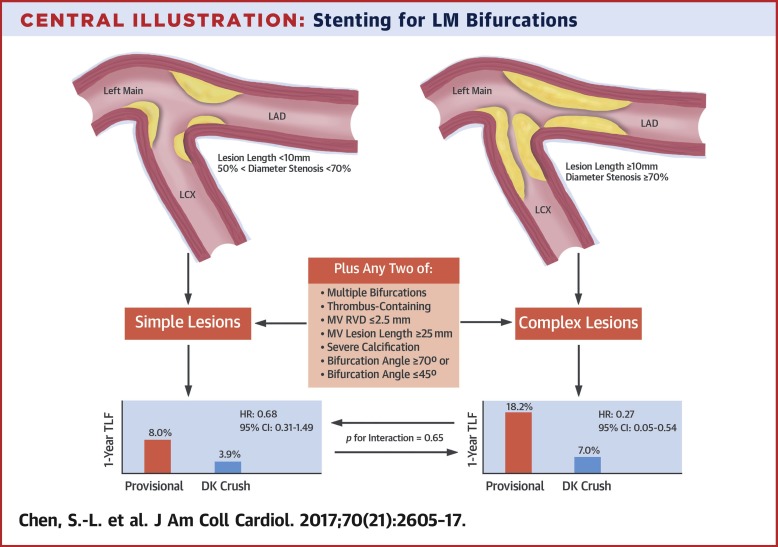
Stenting Left Main
Clinical Trial2017 Nov 28;70(21):2605-2617.
JOURNAL:J Am Coll Cardiol. Article Link
Chen SL, Zhang JJ, Stone GW et al. Keywords: double kissing crush; left main bifurcation lesions; prognosis; provisional stenting
OBJECTIVES - The authors sought to determine whether a planned DK crush 2-stent technique is superior to PS for patients with true distal LM bifurcation lesions.
METHODS - The authors randomized 482 patients from 26 centers in 5 countries with true distal LM bifurcation lesions (Medina 1,1,1 or 0,1,1) to PS (n = 242) or DK crush stenting (n = 240). The primary endpoint was the 1-year composite rate of target lesion failure (TLF): cardiac death, target vessel myocardial infarction, or clinically driven target lesion revascularization. Routine 13-month angiographic follow-up was scheduled after ascertainment of the primary endpoint.
RESULTS - TLF within 1 year occurred in 26 patients (10.7%) assigned to PS, and in 12 patients (5.0%) assigned to DK crush (hazard ratio: 0.42; 95% confidence interval: 0.21 to 0.85; p = 0.02). Compared with PS, DK crush also resulted in lower rates of target vessel myocardial infarction I (2.9% vs. 0.4%; p = 0.03) and definite or probable stent thrombosis (3.3% vs. 0.4%; p = 0.02). Clinically driven target lesion revascularization (7.9% vs. 3.8%; p = 0.06) and angiographic restenosis within the LM complex (14.6% vs. 7.1%; p = 0.10) also tended to be less frequent with DK crush compared with PS. There was no significant difference in cardiac death between the groups.
CONCLUSIONS - In the present multicenter randomized trial, percutaneous coronary intervention of true distal LM bifurcation lesions using a planned DK crush 2-stent strategy resulted in a lower rate of TLF at 1 year than a PS strategy. (Double Kissing and Double Crush Versus Provisional T Stenting Technique for the Treatment of Unprotected Distal Left Main True Bifurcation Lesions: A Randomized, International, Multi-Center Clinical Trial [DKCRUSH-V]; ChiCTR-TRC-11001213).
Copyright © 2017 American College of Cardiology Foundation. All rights reserved.
